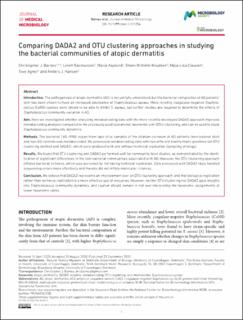| dc.description.abstract | Introduction. The pathogenesis of atopic dermatitis (AD) is not yet fully understood, but the bacterial composition of AD patients’ skin has been shown to have an increased abundance of Staphylococcus aureus. More recently, coagulase-negative Staphylococcus (CoNS) species were shown to be able to inhibit S. aureus, but further studies are required to determine the effects of Staphylococcus community variation in AD. Aim. Here we investigated whether analysing metabarcoding data with the more recently developed DADA2 approach improves metabarcoding analyses compared to the previously used operational taxonomic unit (OTU) clustering, and can be used to study Staphylococcus community dynamics. Methods. The bacterial 16S rRNA region from tape strip samples of the stratum corneum of AD patients (non-lesional skin) and non-AD controls was metabarcoded. We processed metabarcoding data with two different bioinformatic pipelines (an OTU clustering method and DADA2), which were analysed with and without technical replication (sampling strategy). Results. We found that OTU clustering and DADA2 performed well for community-level studies, as demonstrated by the identification of significant differences in the skin bacterial communities associated with AD. However, the OTU clustering approach inflated bacterial richness, which was worsened by not having technical replication. Data processed with DADA2 likely handled sequencing errors more effectively and thereby did not inflate molecular richness. Conclusion. We believe that DADA2 represents an improvement over an OTU clustering approach, and that biological replication rather than technical replication is a more effective use of resources. However, neither OTU clustering nor DADA2 gave insights into Staphylococcus community dynamics, and caution should remain in not overinterpreting the taxonomic assignments at lower taxonomic ranks. | en_US |

